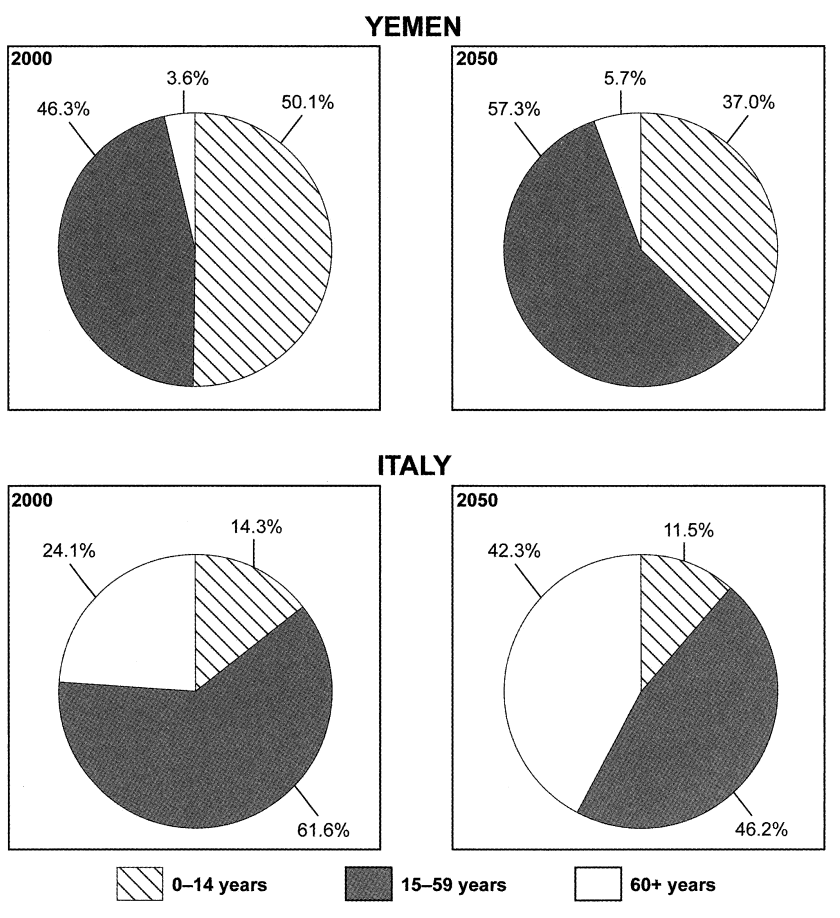Task 1
You should spend about 20 minutes on this task.
The chart below gives information on the ages of population of Yemen and Italy in 2000 and projections for 2050.
Summarise the information by selecting and reporting the main features, and make comparisons where relevant.
Write at least 150 words.

Task 2
You should spend about 40 minutes on this task.
Write about the following topic:
Some people say that the best way to improve public health by increasing the number of sports facilities. Others, however, say that this would have little effect on public health and other measures are required.
Discuss both views and give your own opinion.
Give reasons for your answer and include any relevant examples from your own knowledge or experience.
Write at least 250 words.
Cambridge IELTS 9 Academic Writing Test 3 Task 1 Model Answer (161 words)
The pie charts depict the population distribution across different age groups in Yemen and Italy for the year 2000 and projections for 2050.
In 2000, Yemen had a younger population with over half being under 14, while Italy had more middle-aged citizens. By 2050, Yemen is expected to have an even younger population with over 57% being under 14, while Italy is projected to have a more balanced distribution. The younger generation (0-14 years) is projected to almost double from 14.3% in the year 2000 to approximately 24.1% by the year of prediction in Italy.
Conversely, in Yemen, the percentage of people aged between 15-59 years is expected to decrease from 50.1% to 37%. The elderly population (60+ years) will see a slight increase from 3.6% to an estimated 5.7% in Yemen, while Italy’s elderly populace is expected to decrease from 24.1% to 11.5% by 2050.
Both countries are expected to experience growth in their younger demographics but at varying degrees.
Cambridge IELTS 9 Academic Writing Test 3 Task 2 Model Answer (304 words)
A problem of modern societies is the declining level of health in the general population, with conflicting views on how to tackle this worrying trend. One possible solution is to provide more sports facilities to encourage a more active lifestyle.
Advocates of this believe that today’s sedentary lifestyle and stressful working conditions mean that physical activity is no longer part of either our work or our leisure time. If there were easy-to-reach local sports centres, we would be more likely to make exercise a regular part of our lives, rather than just collapsing in front of a screen every evening. The variety of sports that could be offered would cater for all ages, levels of fitness and interests: those with painful memories of PE at school might be happier in the swimming pool than on the football pitch.
However, there may be better ways of tackling this problem. Interest in sport is not universal, and additional facilities might simply attract the already fit, not those who most need them. Physical activity could be encouraged relatively cheaply, for example by installing exercise equipment in parks, as my local council has done. This has the added benefit that parents and children often use them together just for fun, which develops a positive attitude to exercise at an early age.
As well as physical activity, high tax penalties could be imposed on high-fat food products, tobacco and alcohol, as excessive consumption of any of these contributes to poor health. Even improving public transport would help: it takes longer to walk to the bus stop than to the car.
In my opinion, focusing on sports facilities is too narrow an approach and would not have the desired results. People should be encouraged not only to be more physically active but also to adopt a healthier lifestyle in general.
Leave a Reply